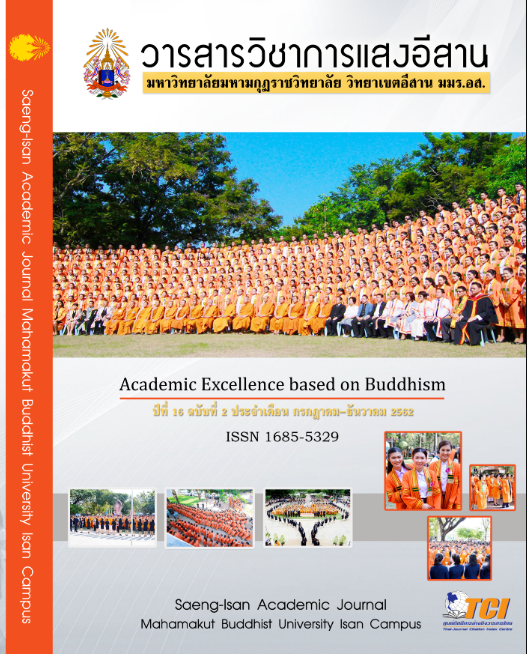An An Analysis of Moral and Generosity in Vessantara Jataka
คำสำคัญ:
Keywords: characteristic, protagonist, good actionบทคัดย่อ
Abstract
This aim offers an analysis of the character of the protagonist in Vessantara Jataka in Theravada Buddhism. The Vessantara ideal of extreme self-sacrifice with special reference to Vessantara’s occupation. The analysis focuses on the moral and those of good actions done by the Vessantara who is the protagonist of the story. The Vessantara Jataka is one of the top widespread Avadanas or a legendary material core on the Buddha’s descriptions of episodes by somebody’s praiseworthy conducts in a former life of Theravada Buddhism. The Vessantara Jataka states the tale of one of Buddha's previous lives, concerning a sympathetic prince, Vessantara, who donates the whole thing he possesses, containing his children, by this means showing the virtue of perfect charity. The Vessantara Story, an account of beyond what is ordinary or usual acting generously, is one of the greatest significant stories in the Buddhist world.
เอกสารอ้างอิง
Appleton, N. (2010). Jataka Stories in Theravada Buddhism: Narrating the Bodhisatta Path. (1, Ed.) Routledge.
Donald, S. K. (1990). Ethics, Wealth and Salvation: A Study in Buddhist Social Ethics. ((eds.), Ed.) South Carolina: University of South Carolina.
Gabaude, L. (2016). “Readers in the Maze, Modern Debates about the Vessantara Story in Thailand”,. in Readings of the Vessantara Jataka, 38.
Gerini, G. (1976). “The Thet Mahā Chāt Ceremony,”. Visakha Puja, May 1976, Buddhist Association of Thailand, Bangkok., 79.
Hans, P. H. (2009). Rediscovering the Buddha: The Legends and Their Interpretations (1st Edition ed.). Oxford: Oxford University Press.
Harvey, P. (2012). An Introduction to Buddhist Ethics. Oxford: Cambridge University Press .
Ladwig, P. (2016). “Emotions and Narrative,. (S. C. (ed.), Ed.) Excessive Giving and Ethical Ambivalence in the lao Vessantara Jātaka”, inReadings of the Vessantara Jataka.
Margaret Cone and Richard F. Gombrich. (1977). The Perfect Generosity of Prince Vessantara. Oxford: Clarendon.
Pesala, B. (1998). The Debate of King Milinda. Delhi: Motital Banarsidass.
Rhys Davids, T. (2013). Buddhist Birth Stories: The Oldest Collection of Folk-Lore Extant. (1, Ed.) London: Routledge.
Richard , G. F. (2008). Buddhist Precept and Practice, Traditional Buddhism in the Rural Highlands of Ceylon. Delhi: Motilal Banarsidass.
Shaw, Sarah 2015: “The Birth Story of Vessantara (Vessantara-jataka), Introduction”, in The Ten Great Birth Stories of the Buddha, The Mahanipata of the Jatakatthavannana, Volume Two, N. Appleton and S. Shaw, 507–534, Chiang Mai: Silkworm Books.
Gerini, G.E. “The Thet Maha Chat Ceremony,” Visakha Puja, May 1976, Buddhist Association of Thailand, Bangkok.
ไฟล์ประกอบ
เผยแพร่แล้ว
ฉบับ
ประเภทบทความ
สัญญาอนุญาต
เนื้อหาและข้อมูลในบทความที่ตีพิมพ์ในวารสาร ถือเป็นข้อคิดเห็นและความรับผิดชอบของผู้เชียนบทความโดยตรง ซึ่งวารสารไม่มีส่วนเกี่ยวข้อง นอกจากนั้น ผู้เขียนทุกท่านต้องยืนยันว่าบทความต้นฉบับที่ส่งมาตีพิมพ์เผยแพร่นั้น จะต้องไม่เป็นบทความที่กำลังอยู่ในการพิจารณาเพื่อตีพิมพ์ในวารสารอื่นหรือเคยตีพิมพ์เผยแพร่มาแล้ว หากมีการใช้ภาพ ข้อความหรือตารางของผู้เขียนหรือผู้นิพนธ์ท่านอื่น ผู้เขียนจะต้องอ้างแหล่งที่มาหรือเจ้าของลิขสิทธ์
Publication Ethic:
The detail published in Saeng Isan Journal is opinion and responsibility of the authors, and it is not relevant with the jouranl. Besides, the authors must certify that the original manuscript is not in the process to publish in other journals or used to publish in other journals. If the authors use paragraphs, pictures or tables from others, the athours must refer to the original sources.
Article Consideration:
Each article will be published by a panel three journalists with expertise in relevant fields, and get the editorial approval before publishing. The review is in the form of The article's double blind.
To comply with copyright law. The author must sign the copy of the article submission form to the journal. In addition, the author must confirm that the original article submitted to the journal is only one publication in Saeng Isan Journal. If the images or tables of other authors appearing in other publications are used, the author must ask permission of the copyright owner before publishing.


